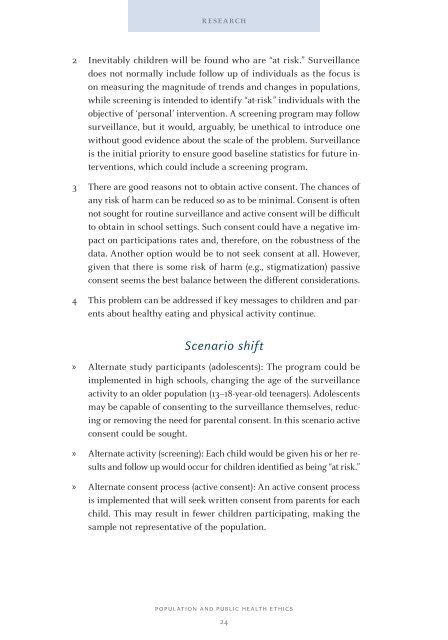PoPulationand Public HealtH etHics
PoPulationand Public HealtH etHics
PoPulationand Public HealtH etHics
You also want an ePaper? Increase the reach of your titles
YUMPU automatically turns print PDFs into web optimized ePapers that Google loves.
esearch<br />
2 Inevitably children will be found who are “at risk.” Surveillance<br />
does not normally include follow up of individuals as the focus is<br />
on measuring the magnitude of trends and changes in populations,<br />
while screening is intended to identify “at-risk” individuals with the<br />
objective of ‘personal’ intervention. A screening program may follow<br />
surveillance, but it would, arguably, be unethical to introduce one<br />
without good evidence about the scale of the problem. Surveillance<br />
is the initial priority to ensure good baseline statistics for future interventions,<br />
which could include a screening program.<br />
3 There are good reasons not to obtain active consent. The chances of<br />
any risk of harm can be reduced so as to be minimal. Consent is often<br />
not sought for routine surveillance and active consent will be difficult<br />
to obtain in school settings. Such consent could have a negative impact<br />
on participations rates and, therefore, on the robustness of the<br />
data. Another option would be to not seek consent at all. However,<br />
given that there is some risk of harm (e.g., stigmatization) passive<br />
consent seems the best balance between the different considerations.<br />
4 This problem can be addressed if key messages to children and parents<br />
about healthy eating and physical activity continue.<br />
Scenario shift<br />
» Alternate study participants (adolescents): The program could be<br />
implemented in high schools, changing the age of the surveillance<br />
activity to an older population (13–18-year-old teenagers). Adolescents<br />
may be capable of consenting to the surveillance themselves, reducing<br />
or removing the need for parental consent. In this scenario active<br />
consent could be sought.<br />
» Alternate activity (screening): Each child would be given his or her results<br />
and follow up would occur for children identified as being “at risk.”<br />
» Alternate consent process (active consent): An active consent process<br />
is implemented that will seek written consent from parents for each<br />
child. This may result in fewer children participating, making the<br />
sample not representative of the population.<br />
PoPulation anD <strong>Public</strong> <strong>HealtH</strong> <strong>etHics</strong><br />
24
















